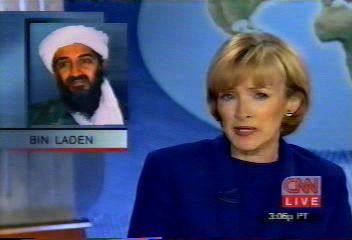
Globalizing
Political Action:
Building bin Laden and Getting Ready for 9/11
Francis A. Beer
G. R. Boynton
As globalization gathers momentum at the beginning of the 21st century, global
communication is increasingly important. Part of this process is global news,
which has emerged as a separate genre made possible by the development of new
communication technology. Media elites have used the ability to communicate
from anywhere to anywhere in real time to create a new global space, which has
become a domain for global political action. In this space, media elites mix
political content with entertainment values in news reality television, the
global political theater of the real. Capturing images from the vast ocean of
daily human activity, they create breaking news. They help construct dramatic
political characters like Osama bin Laden. They weave past and present experience
together in gripping ongoing stories like terrorism that give meaning to current
events and prefigure the future.
Bin Laden Breaks into CNN WorldView
One of the early practitioners of global broadcasting was CNN. Their evening news program, WorldView, was broadcast "live around the world." CNN and other global broadcasters have connected political actors, who previously played only in local contexts to local audiences, with a new global audience and have created a new global space for political actors.
Many of the political actors are familiar: U.S. President George W. Bush, British Prime Minister Tony Blair, French President Jacques Chirac, Russian President Vladimir Putin. These actors owe their presence on the world stage to their formal status as elected government officials who are authorized to speak for the political communities they legally represent. The characters are familiar and they deliver standard national story lines. Other actors, however, have different profiles.
Osama bin Laden is a new actor. He emerged from the caves of Afghanistan onto the world media stage, and by September 11, 2001 he was one of its most thoroughly covered figures. Bin Laden was part of one or more stories in 67 of the 501 broadcasts that we recorded between August 1998 and the end of 2000. The table gives the relative position of bin Laden in WorldView broadcasting during this period.
| WorldView Broadcasts August 1998 through 2000 |
|||
Table 1 |
|||
Total Broadcasts |
501 |
80 |
Annan |
Clinton |
441 |
67 |
bin Laden |
Albright |
158 |
60 |
Blair |
Arafat |
151 |
59 |
Netanyahu |
Yeltsin |
132 |
34 |
Schroeder |
Gore |
118 |
33 |
Jiang Zemin |
Putin |
87 |
29 |
Mubarak |
Cohen |
84 |
15 |
Chirac |
After U.S. President Clinton's 441 appearances the numbers fall off very sharply. That Secretary of State Albright was second and Secretary of Defense Cohen was seventh is an indication of how the Clinton administration was involved in the global domain. Bin Laden was ninth, appearing on average in two stories a month. He was mentioned in more broadcasts than Blair of England, Netanyahu of Israel, Schroeder of Germany, Jiang Zemin of China, Mubarak of Egypt and Chirac of France.
 |
WorldView December 2, 1998 |
By December of 1998 Osama bin Laden had become the face of terror, an iconic representation, looming over the shoulder of the anchor person, the personalization of the war of terror in which he was playing such a large role. In an earlier work we examined how the major global news programs -- CNN's WorldView and BBC's World News -- presented global terror (Beer and Boynton, 2003). Here we focus on the way they personified terror, how they have built bin Laden into terror's icon. We concentrate on CNN's WorldView during the years 1998-2000. When did bin Laden first appear, and how frequently after that? With which events was he associated and how was he described? And, most importantly, what are the consequences of building bin Laden for the news programs themselves, for the broader global media, for international communication, and for world politics? We recorded 501 broadcasts of WorldView between August of 1998 and the end of 2000. These broadcasts are the basis of our analysis.
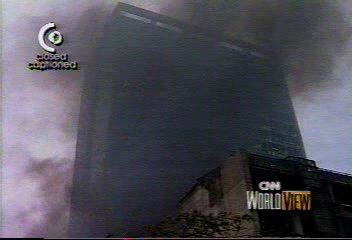 |
Click Image to Play Video 00:28 |
August 7, 1998 -- the U.S. embassies in Kenya and Tanzania were simultaneously bombed. Everywhere there was fire, smoke, rubble, rescue workers and persons being carried out of the rubble. The deaths numbered in the hundreds; the injuries numbered in the thousands.
No one claimed responsibility for the bombing. No one was a suspect. There was shock and mystery; shock that the bombing had occurred, and mystery about who the terrorists were. The reporters did not know. The people in Kenya and Tanzania did not know. The U.S. government did not know.
It was not until August 12 that bin Laden was mentioned on WorldView. Five days after the event, viewers were told that there had been unusual movement at bin Laden's camp. It was another week before bin Laden was mentioned again. On August 19 WorldView reported that a terrorist organization had threatened the United States. The founders of the organization included Osama bin Laden, and officials said bin Laden had been involved with the bombing in Kenya and Tanzania. The next day the U.S. aimed cruise missiles at his camps in the mountains between Afghanistan and Pakistan and at a pharmaceutical factory in Sudan. That day, August 20, the entire broadcast was devoted to a press conference by Secretary of State Albright and NSA chief Berger. They laid out the argument for the attack. It was an argument that required considerable elaboration in the next few days as Sudan made the case against the U.S. attack.
Osama bin Laden appeared on the scene August 7, 1998, though he was not named until August 12. He was not in any of the broadcasts earlier in 1998, that we recorded. We also checked the CNN website. There were 454 stories mentioning bin Laden through 2000. One story was from 1996. Three were from 1998, but before August. The other 450 were August 7 and after. August 7 was his introduction to the global audience of WorldView. Never again would it take five days for bin Laden's name to arise as acts of terror were committed.
The second terrorist attack was in November of 1999. The U.S. embassy and U.N. office buildings in Islamabad, Pakistan were attacked with rocket launchers mounted on automobiles. The aiming devices were crude and the aim faulty. Only a modest amount of destruction and injury occurred. That day a senior Pakistani official said it could have been bin Laden. The spokesman for the U.S. State Department said bin Laden could not be ruled out. Other groups were mentioned. Bin Laden was the only person named.
October 12, 2000 a small boat pulled up beside the USS Cole and blew a hole in the side of the ship. The terrorists in the small boat were killed. U.S. sailors were killed by the force of the explosion as well as by the water rushing into the ship. The USS Cole had pulled into the harbor in Yemen to refuel. The terrorists took advantage of the opportunity. Secretary of Defense Cohen said "there is no evidence to link this to specific terrorist groups such as accused terrorist Osama bin Laden." There is no evidence, but the U.S. knew where to look for evidence.
It appears that bin Laden, if he was the planner, liked the fall of the year. All three happened in the fall, and the next terrorist attack was in September.
These are the 'high points' on the trail of terror for bin Laden, if he was the culprit. However, the terrorist fighters were also a part of the trail of terror. Most of the 67 stories are about something the investigators did to counter bin Laden [link to summary of stories].
Suspects were captured, indicted, and tried. And they were said to have links to bin Laden and his organization. Threatening communications were intercepted, investigated, and security alerts put into effect. In December, 1998 the U.S. government warned that bin Laden might be attempting a terrorist attack in New York. Secretary Cohen did not stop in Albania because of threats. Six U.S. embassies in African nations were closed in June of 1999. There were more threats in December, 1999. The U.S. feared that terrorists attacks would take place at the turn of the millennium. Seattle canceled its New Years celebration when a person, who was connected to someone who might be connected to bin Laden, made his way across the border with materials for making bombs. Embassies were put on high alert. U.S. troops in the Middle East were brought to threat condition delta. And every time the threats were connected to bin Laden, whether with proof or not.
U.S. authorities took actions to fight the terrorists. The FBI made bin Laden one of its ten most wanted. A rapid response to terrorism organization was set up in Washington D.C. The FBI set up a terrorism group headed by an assistant director of the Bureau. The FBI set up procedures to guarantee that top officials in the bureau would have rapid access to any evidence of terrorist threat.
Three spots on the trail were acted out by bin Laden. But the trail was filled by actions of authorities attempting to prevent terrorism. Every other week there was a new indictment mentioning bin Laden or a threat warning mentioning bin Laden or the announcement of government reorganization mentioning bin Laden. Other terrorists faded into obscurity, which may well have been what they preferred.
An interesting point about this trail of terror is that it is filled with threatening communication intercepted by the authorities and actions to warn and to change procedures for protection. However, there appear to have been no threats concerning the bombing of the embassies in Kenya and Tanzania. There were no threats concerning the rockets launched against U.S. and U.N. buildings in Pakistan. Nor were there threats before the USS Cole was bombed. One interpretation is: terrorists communicate threats to keep officials chasing terrorists busy and to cover the actions they expect to take.
Terrorism was the news from Kenya and Tanzania, to Pakistan, and to the USS Cole. And Osama bin Laden was presented as the mastermind of these threats.
The first characterizations of bin Laden, in August 1998, told that he was an exile from Saudi Arabia, that he left with millions of dollars, that he was based in Afghanistan, that he had good connections with other Muslim terrorist groups, that he was linked to the bombings in Kenya and Tanzania, and that he had been a Ronald Reagan freedom fighter driving the Soviets out of Afghanistan.
Later one reporter called Osama bin Laden the world's number one terrorist. Given the standard characterizations used by reporters it is easy to see how a reporter could conclude that number one was the correct characterization.
Bin Laden was the terrorist mastermind [19 times] who planned and carried out the bombings of U.S. embassies in Kenya and Tanzania [25 times]. The 1998 bombings did not fade away; bin Laden was as frequently characterized as responsible for the bombings in 2000 as in 1998. The horror, the destruction, the deaths of 1998 became a permanent facet of his person. And it was almost always mastermind. He was the man behind the scene, recruiting, planning, and directing terrorism. [link to counts]
Mastermind meant that he was directing the operations. His leadership was regularly identified by claiming links between the people who were captured and bin Laden [16 times]. They were evil because they were associated with him. He was the center of the movement by being linked to all of them. After the bombing of the USS Cole the U.S. raised the threat level for troops because of a threat from an Egyptian militant -- who was sitting next to bin Laden in a videotape broadcast.
Mastermind meant that he was issuing threats [16 times]. When threats were picked up by government officials they frequently identified the source of the threat as bin Laden or his organization.
The mastermind of terrorism was a man -- Osama bin Laden. Is it only he who was portrayed by the media? What about his organization Al Qaeda? Al Qaeda appears in these texts only twice, and each time it was spelled Al Quaida, which was the initial spelling that has been transformed to Al Qaeda. The usual designations were organization [10 times], group [5 times], and terrorist ring or network [8 times]. However, in each case it was bin Laden's organization or bin Laden's group, or the terrorist network led by bin Laden. The organization had reality only as a reflection of its leader.
How did they personalize the reporting? Here are two sentences that illustrate their practice of personalizing.
U.S. intelligence agencies warn Osama bin Laden may be preparing terrorists strikes in Washington D.C. or New York City. Bin Laden has been blamed for explosions at the U.S. embassies in Kenya and Tanzania.
Work that requires an organization is attributed to the head of the organization. The head becomes superman except we, the viewers, all know better. It does, however, keep the name, the person at the forefront of our consciousness.
One point at which 'organization' became important was attribution of blame.
A senior official described Yemen as "a U.N. for terrorists" but said the sophistication of the attack still suggests an established group -- bin Laden's, or perhaps Hezbollah.
Four times officials said that the sophistication of the attack suggested an established organization. The attack against the USS Cole was sophisticated. It must have been an established organization; probably bin Laden's.
To be sure the language of the reporters was more careful than it has been characterized here. He was the accused terrorist mastermind, the suspected terrorist or the alleged leader of a terrorist network. He was the world's number one terrorist, but with a disclaimer.
The mastermind of terror became a villain in the west and became a hero in some parts of Islam.
[in Pakistan] where bin Laden is a popular myth thanks to the strength of the fundamentalist parties and the publicity surrounding him. . . .
The Taliban say the accusation [that bin Laden was involved with the bombing of the USS Cole] and the response has only increased bin Laden's stature among those who oppose the United States.
 |
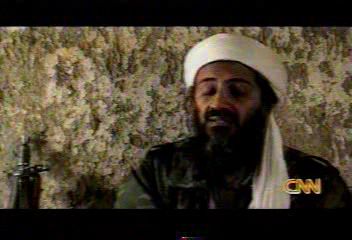 |
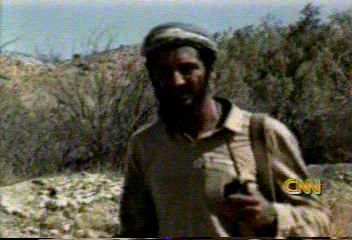 |
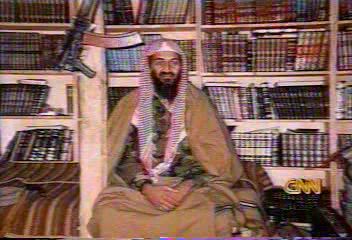 |
These were the first bin Laden images on WorldView. The black and white photograph was used on the first day and was a still image. It might have been an image taken from the videoclip on its right. The other three are taken from videoclips and they were showed on the second day of coverage.
Bin Laden is a warrior. He has his picture taken with his guns and his communication equipment. Pictured as a warrior fits the story the network was telling.
 |
| Click the image to play video 00:49 |
There are few pictures of bin Laden. He is hiding, and paparazzi need not apply. The mountains, the caves, and the guns keep them out. Most of the clips seem to have come from videotapes made by bin Laden to be broadcast on television. Click on the image to the right to see how frequently the same images were used by WorldView. For each day one image was extracted from each videoclip used by WorldView. They were then put in chronological order to show how bin Laden was pictured. There are 90 images in the video; some appearing in many different broadcasts.
The images are repeated over and over. It becomes a familiar face: the dark face, the strong eyes, hair that is black and becomes increasingly gray over time. Osama bin Laden is no longer an abstraction, a name without a face. He becomes the face of terror, an actor in the global theater of the real.
Political Action in the Global Theater of the Real
Personalization is an important practice of television news, and it is clearly part of terrorism coverage. The media do not give a lecture about terrorism; they tell a story about a terrorist person undertaking terrorist actions. Bin Laden is the personification of terror; other persons or groups are infrequently mentioned, and the first mention is not reinforced with subsequent mentions. Osama bin Laden was not already a media person, but he became one as news broadcasters and politicians settled on him to play the role of the terrorist leader, the face of terror. Taking what was already there, they personalized and dramatized it, making it visible to all.
CNN WorldView built bin Laden into terror's icon during the years 1998-2000. Though there were a few earlier appearances, bin Laden's major entrance onto the world stage occurred in August, after the attack on the embassies in Kenya and Tanzania and in connection with U.S. retaliatory missile strikes on targets in Afghanistan and Sudan. Taking the period as a whole, bin Laden was the ninth most cited political actor. He was depicted as the face, the mastermind on the trail of terror. He was the classic villain, the personification of evil, the essential Other. As Che Guevara had been the mythical revolutionary for an earlier generation, bin Laden now became the mythical terrorist.
While the media built bin Laden, they were also getting ready for 9/11. When the planes flew into the buildings, they found characters (Bin Laden) and backstory (The Trail of Terror) waiting: Bin Laden was the face of terror, the mastermind on the trail of terror. 9/11 was the latest installment in the serial. 9/11 had been prefigured, preinterpreted, and prepackaged. The franchise was in place; the sequel was ready. The audience had seen the trailers on news reality TV. They were primed for the main event: lights, camera, action.
The media have developed the global theater of the real. It provides space for both actors and audience. The actors can perform at any spot on the world stage. Media stars like Ronald Reagan, Jesse Ventura, and Arnold Schwarzennegger have shown that celebrity in American entertainment and celebrity in politics are strongly connected. Performing actors from movies and television have become political actors, turning cultural capital into political capital. New independent actors, political entrepreneurs like bin Laden, can break into the game, a global version of the typical American success story. They bring new faces and power to the spectacle, but do not require expensive scripts or sets, agents or financial deals. They establish an emotional connection, a distant intimacy, with the audience. When members of the audience see the face of bin Laden, they reexperience fear and hatred of the familiar character. They can share the thrill of victory and the agony of defeat in the comfort of their own homes for the low, low price of standard television. Corporate sponsors can control their marketing costs.
The global news media have created not only compelling theater, but also an expanded space for global political action on the global television screen. Before television, this space was formerly reserved for heads of state and their most trusted advisors. This realist world was dominated by disciplined statesmen, supposedly acting rationally on the basis of national interest. They met quietly and reached agreements, free from what Hans Morgenthau called "the vice of publicity." Woodrow Wilson was the prophetic voice of the 20th century that challenged this system, when he called for "open covenants, openly arrived at." The human catastrophes of two world wars, the dynamics of democracy, and increasing publicity gradually forced open the jaws of the old reality. Political Heroes like Franklin Roosevelt and Dwight Eisenhower battled against villains like Hitler and Stalin in morality plays of good and evil. Contemporary roles have become more ambivalent:: Henry Kissinger claims to be the diplomatic descendant of Metternich, but Christopher Hitchens compares him with Eichmann. Bin Laden elicits hisses and cheers; he is villain to one audience, but hero to another
During the 21st century, politics and entertainment increasingly bleed into each other. In this post-realist environment, media actors, with new voices and new resources, aggressively search for new audience: Ted Turner meets Osama bin Laden. As the media construct characters and stories, they help create the content and context of contemporary world politics. Building bin Laden as a player and getting ready for the spectacle of 9/11, the news media are at work, using professional production values to transform local people and real time events into powerful global political actors and concrete action sequences, trying to make public sense of a crazy, frightening world.
Beer, Francis A. and G. Robert Boynton. 2003. "Globalizing Terror." POROI Journal. vol. 2 no. 1.